Sustainable Geopolymer Tuff Composites Utilizing Iron Powder Waste: Rheological and Mechanical Performance Evaluation
Abstract
1. Introduction
2. Materials and Methods
2.1. Raw Materials
2.2. Geopolymer Mortar with Volcanic Tuff (VTF) and Iron Powder (IP)
3. Result and Discussion
3.1. Air Content and Bulk Density
3.2. Workability (Flow Time)
3.3. Compressive Strength
3.4. Three-Point Bending Strength
3.5. Correlation Between Flexural and Compressive Strength
4. Conclusions
Author Contributions
Funding
Institutional Review Board Statement
Informed Consent Statement
Data Availability Statement
Conflicts of Interest
References
- Ürünveren, H.; Beycíoğlu, A.; Resuloğulları, E.Ç.; Diíşken, N.B. A comparative investigation of eco-friendly fly ash-based geopolymer mortar produced by using electrical and heat curing: Mechanical properties, energy consumption and cost. Constr. Build. Mater. 2024, 439, 137200. [Google Scholar] [CrossRef]
- El Moustapha, B. Formulation et Étude d’un Géopolymère Accumulateur d’Énergie Thermique dans le Cadre de l’Éco-Construction des Bâtiments. Doctoral Dissertation, HESAM Université, Université de Nouakchott, Nouakchott, Mauritania, 2023. [Google Scholar]
- U.S. Geological Survey. Mineral Commodity Summaries; U.S. Geological Survey: Reston, VA, USA, 2015; p. 196. [CrossRef]
- Khaiyum, M.Z.; Sarker, S.; Kabir, G. Evaluation of carbon emission factors in the cement industry: An emerging economy context. Sustainability 2023, 15, 15407. [Google Scholar] [CrossRef]
- Rossignol, S.; Gharzouni, A. Géopolymères—Précurseurs et Propriétés. Tech. L’ingénieur 2022, 3303, 1–18. [Google Scholar] [CrossRef]
- Shen, W.G.; Cao, L.; Li, Q.; Zhang, W.S.; Wang, G.M.; Li, C.C. Quantifying CO2 Emissions from China’s Cement Industry. Renew. Sustain. Energy Rev. 2015, 50, 1004–1012. [Google Scholar] [CrossRef]
- Kępniak, M.; Recha, F.; Prochoń, P. Application of a Generalized Utility Function to Determine the Optimal Composition of Geopolymer Mortar. Materials 2024, 17, 6237. [Google Scholar] [CrossRef]
- Davidovits, J. Geopolymer Chemistry and Applications; Institut Géopolymère: Saint-Quentin, France, 2011. [Google Scholar]
- Jwaida, Z.; Dulaimi, A.; Mashaan, N.; Othuman Mydin, M.A. Geopolymers: The green alternative to traditional materials for engineering applications. Infrastructures 2023, 8, 98. [Google Scholar] [CrossRef]
- Zhang, J.; Ge, Y.; Li, Z.; Wang, Y. Facile Fabrication of a Low-Cost and Environmentally Friendly Inorganic–Organic Composite Membrane for Aquatic Dye Removal. J. Environ. Manag. 2020, 256, 109969. [Google Scholar] [CrossRef]
- Aouan, B.; Alehyen, S.; Fadil, M.; El Alouani, M.; Saufi, H.; El Makhoukhi, F.; Taibi, M.H. Development and Optimization of Geopolymer Adsorbent for Water Treatment: Application of Mixture Design Approach. J. Environ. Manag. 2023, 338, 117853. [Google Scholar] [CrossRef]
- Lahoti, M.; Tan, K.H.; Yang, E.H. A Critical Review of Geopolymer Properties for Structural Fire-Resistance Applications. Constr. Build. Mater. 2019, 221, 514–526. [Google Scholar] [CrossRef]
- Aiken, T.A.; Kwasny, J.; Sha, W.; Soutsos, M.N. Effect of Slag Content and Activator Dosage on the Resistance of Fly Ash Geopolymer Binders to Sulfuric Acid Attack. Cem. Concr. Res. 2018, 111, 23–40. [Google Scholar] [CrossRef]
- Samantasinghar, S.; Singh, S.P. Effect of Synthesis Parameters on Compressive Strength of Fly Ash-Slag Blended Geopolymer. Constr. Build. Mater. 2018, 170, 225–234. [Google Scholar] [CrossRef]
- Çelik, A.I.; Özkılıç, Y.O.; Bahrami, A.; Hakeem, I.Y. Mechanical performance of geopolymer concrete with micro silica fume and waste steel lathe scraps. Case Stud. Constr. Mater. 2023, 19, e02548. [Google Scholar] [CrossRef]
- Yang, M.J.; Paudel, S.R.; Asa, E. Comparison of Pore Structure in Alkali-Activated Fly Ash Geopolymer and Ordinary Concrete due to Alkali-Silica Reaction Using Micro-Computed Tomography. Constr. Build. Mater. 2020, 236, 117524. [Google Scholar] [CrossRef]
- Wan, Q.; Zhang, Y.; Zhang, R. The Effect of Pore Behavior and Gel Structure on the Mechanical Property at Different Initial Water Content. Constr. Build. Mater. 2021, 309, 125146. [Google Scholar] [CrossRef]
- Hajimohammadi, A.; Ngo, T.; Mendis, P. How Does Aluminium Foaming Agent Impact the Geopolymer Formation Mechanism? Cem. Concr. Compos. 2017, 80, 277–286. [Google Scholar] [CrossRef]
- Shill, S.K.; Al-Deen, S.; Ashraf, M.; Hutchison, W. Resistance of Fly Ash-Based Geopolymer Mortar to Both Chemicals and High Thermal Cycles Simultaneously. Constr. Build. Mater. 2020, 239, 117886. [Google Scholar] [CrossRef]
- Zailani, W.W.A.; Norain, M.N.; Apandi, N.M.; Tahir, M.F.M.; Faris, M.A.; Abdullah, M.M.A.B.; Razak, R.A.; Sinarta, I.N.; Agustini, N.K.A. Properties and performance of fly ash–based geopolymer as concrete repair material. In Recent Developments of Geopolymer Materials; Woodhead Publishing: Cambridge, UK, 2025; pp. 163–179. [Google Scholar]
- Faris, M.A.; Abdullah, M.M.A.B.; Tahir, M.F.M.; Hashim, M.F.A.; Zailani, W.W.A. Properties of fly ash–metakaolin-based geopolymer concrete by inclusion steel fibers. In Recent Developments of Geopolymer Materials; Woodhead Publishing: Cambridge, UK, 2025; pp. 181–199. [Google Scholar]
- Łach, M.; Pławecka, K.; Bąk, A.; Lichocka, K.; Korniejenko, K.; Cheng, A.; Lin, W.T. Determination of the influence of hydraulic additives on the foaming process and stability of the produced geopolymer foams. Materials 2021, 14, 5090. [Google Scholar] [CrossRef]
- Bhutta, A.; Farooq, M.; Banthia, N. Performance characteristics of micro fiber-reinforced geopolymer mortars for repair. Constr. Build. Mater. 2019, 215, 605–612. [Google Scholar] [CrossRef]
- Tammam, Y.; Uysal, M.; Canpolat, O. Effects of alternative ecological fillers on the mechanical, durability, and microstructure of fly ash-based geopolymer mortar. Eur. J. Environ. Civ. Eng. 2022, 26, 5877–5900. [Google Scholar] [CrossRef]
- Zhang, Y.; Liu, W.H.; Liu, M.H. Setting time and mechanical properties of chemical admixtures modified FA/GGBS-based engineered geopolymer composites. Constr. Build. Mater. 2024, 431, 136473. [Google Scholar] [CrossRef]
- Liu, X.H.; Hu, C.F.; Chu, L.S. Microstructure, compressive strength, and sound insulation property of fly ash-based geopolymeric foams with silica fume as a foaming agent. Materials 2020, 13, 3215. [Google Scholar] [CrossRef] [PubMed]
- Sindhunata, A. Conceptual Model of Geopolymerisation. Ph.D. Thesis, University of Melbourne, Melbourne, Australia, 2006. [Google Scholar]
- Bai, C.Y.; Zheng, J.; Rizzi, G.A.; Colombo, P. Low-temperature fabrication of SiC/geopolymer cellular composites. Compos. B Eng. 2018, 137, 23–30. [Google Scholar] [CrossRef]
- Kabirova, A.; Uysal, M.; Hüsem, M.; Aygörmez, Y.; Dehghanpour, H.; Pul, S.; Canpolat, O. Physical and mechanical properties of metakaolin-based geopolymer mortars containing various waste powders. Eur. J. Environ. Civ. Eng. 2023, 27, 437–456. [Google Scholar] [CrossRef]
- Sarazin, J.; Davy, C.A.; Bourbigot, S.; Tricot, G.; Hosdez, J.; Lambertin, D.; Fontaine, G. Flame resistance of geopolymer foam coatings for the fire protection of steel. Compos. B Eng. 2021, 222, 109045. [Google Scholar] [CrossRef]
- Matalkah, F.; Aqel, R.; Ababneh, A. Enhancement of the mechanical properties of kaolin geopolymer using sodium hydroxide and calcium oxide. Procedia Manuf. 2020, 44, 164–171. [Google Scholar] [CrossRef]
- Qiao, Y.; Li, X.; Bai, C.; Li, H.; Yan, J.; Wang, Y.; Wang, X.; Zhang, X.; Zheng, T.; Colombo, P. Effects of surfactants/stabilizing agents on the microstructure and properties of porous geopolymers by direct foaming. J. Asian Ceram. Soc. 2021, 9, 412–423. [Google Scholar] [CrossRef]
- Mohammed, D.T.; Yaltay, N. Strength and elevated temperature resistance properties of the geopolymer paste produced with ground granulated blast furnace slag and pumice powder. Ain Shams Eng. J. 2024, 15, 102483. [Google Scholar] [CrossRef]
- Liang, G.; Zhu, H.; Zhang, Z.; Wu, Q.; Du, J. Investigation of the waterproof property of alkali-activated metakaolin geopolymer added with rice husk ash. J. Clean. Prod. 2019, 230, 603–612. [Google Scholar] [CrossRef]
- Djobo, J.N.Y.; Elimbi, A.; Tchakouté, H.K.; Kumar, S. Mechanical properties and durability of volcanic ash-based geopolymer mortars. Constr. Build. Mater. 2016, 124, 606–614. [Google Scholar] [CrossRef]
- Buchwald, A.; Vanooteghem, M.; Gruyaert, E.; Hilbig, H.; de Belie, N. Purdocement: Application of alkali-activated slag cement in Belgium in the 1950s. Mater. Struct. 2015, 48, 501–511. [Google Scholar] [CrossRef]
- Ye, J.; Zhang, W.; Shi, D. Properties of an aged geopolymer synthesized from calcined ore-dressing tailing of bauxite and slag. Cem. Concr. Res. 2017, 100, 23–31. [Google Scholar] [CrossRef]
- González-García, D.M.; Téllez-Jurado, L.; Jiménez-Álvarez, F.J.; Balmori-Ramírez, H. Structural Study of Geopolymers Obtained from Alkali-Activated Natural Pozzolan Feldspars. Ceram. Int. 2017, 43, 2606–2613. [Google Scholar] [CrossRef]
- Yu, Z.; Zhang, T.; Deng, Y.; Han, Y.; Zhang, T.; Hou, P.; Zhang, G. Microstructure and Mechanical Performance of Alkali-Activated Tuff-Based Binders. Cem. Concr. Compos. 2023, 139, 105030. [Google Scholar] [CrossRef]
- Waqas, R.M.; Zaman, S.; Alkharisi, M.K.; Butt, F.; Alsuhaibani, E. Influence of Bentonite and Polypropylene Fibers on Geopolymer Concrete. Sustainability 2024, 16, 789. [Google Scholar] [CrossRef]
- Raza, A.; Selmi, A.; Elhadi, K.M.; Ghazouani, N.; Chen, W. Strength analysis and microstructural characterization of calcined red mud based-geopolymer concrete modified with slag and phosphogypsum. J. Mater. Res. Technol. 2024, 33, 6168–6181. [Google Scholar] [CrossRef]
- Özdemir, M.H.S.; Bayrak, B.; Aydın, A.C. Bond performance of geopolymer concrete with bazalt/glass fiber under elevated temperature. Eng. Struct. 2025, 324, 119368. [Google Scholar] [CrossRef]
- Korniejenko, K.; Pławecka, K.; Bulut, A.; Şahin, B.; Azizağaoğlu, G.; Figiela, B. Development of Lightweight Geopolymer Composites Containing Perlite and Vermiculite. J. Achiev. Mater. Manuf. Eng. 2023, 117, 49–56. [Google Scholar] [CrossRef]
- Ören, O.H.; Mandev, E.; Kaya, M.; Sarı, A.; Hekimoğlu, G.; Çıkman, İ.Ü.; Subaşı, S.; Maraşlı, M.; Gencel, O. Effects of microencapsulated phase change material on physico-mechanical and thermoregulation performance of lightweight geopolymer concrete with zeolite and perlite. J. Energy Storage 2025, 109, 115225. [Google Scholar] [CrossRef]
- Ghafoori, N.; Najimi, M.; Radke, B. Natural Pozzolan-Based Geopolymers for Sustainable Construction. Environ. Earth Sci. 2016, 75, 55. [Google Scholar] [CrossRef]
- Acar, M.C.; Celik, A.I.; Kayabaşı, R.; Şener, A.; Özdöner, N.; Özkılıç, Y.O. Production of perlite-based-aerated geopolymer using hydrogen peroxide as eco-friendly material for energy-efficient buildings. J. Mater. Res. Technol. 2023, 24, 81–99. [Google Scholar] [CrossRef]
- Çelik, A.I.; Karalar, M.; Aksoylu, C.; Mydin, A.O.; Althaqafi, E.; Yılmaz, F.; Umiye, O.A.; Özkılıç, Y.O. Effect of GBFS ratio and recycled steel tire wire on the mechanical and microstructural properties of geopolymer concrete under ambient and oven curing conditions. Case Stud. Constr. Mater. 2024, 21, e03890. [Google Scholar] [CrossRef]
- Çelik, A.I. Lightweight geopolymer concrete using pumice and glass fiber. Comput. Concr. 2024, 34, 577–589. [Google Scholar]
- Wang, C.; Zhang, Z.; Liu, X.; Zhang, Y.; Ma, Z. Elucidating the role of recycled concrete aggregate in ductile engineered geopolymer composites: Effects of recycled concrete aggregate content and size. J. Build. Eng. 2024, 95, 110150. [Google Scholar] [CrossRef]
- Wu, H.; Liu, X.; Wang, C.; Zhang, Y.; Ma, Z. Micro-properties and mechanical behavior of high-ductility engineered geopolymer composites (EGC) with recycled concrete and paste powder as green precursor. Cem. Concr. Compos. 2024, 152, 105672. [Google Scholar] [CrossRef]
- Kępniak, M.; Chyliński, F.; Łukowski, P.; Woyciechowski, P. Recycled Aggregate Integration for Enhanced Performance of Polymer Concrete. Materials 2024, 17, 4007. [Google Scholar] [CrossRef]
- Davidovits, J. Ferro-Sialate Geopolymers; Technical Papers #27; Geopolymer Institute Library: Saint-Quentin, France, 2020. [Google Scholar]
- Wu, X.; Zhou, X.; Guo, C.; Kang, D.; Zhang, W.; Lan, J.; Fang, Z. Behavior of Hematite, Magnetite, and Reduced Iron Powder in Geopolymers: Effects on Mechanical Properties and Reaction Mechanism. J. Clean. Prod. 2024, 444, 141178. [Google Scholar] [CrossRef]
- Gulmez, N.; Kockal, N.U. Effects of Iron Powder on Properties of Geopolymers Subjected to Different Curing Regimes. J. Clean. Prod. 2021, 296, 126667. [Google Scholar]
- Akbulut, Z.F.; Guler, S.; Khan, M. The Effects of Waste Iron Powder and Steel Fiber on the Physical and Mechanical Properties of Geopolymer Mortars Exposed to High Temperatures. Structures 2023, 58, 105398. [Google Scholar] [CrossRef]
- Ma, T.; Gu, G.; Chen, F.; Wang, N. Influence of Iron Powder Content on the Electromagnetic and Mechanical Performance of Soft Magnetic Geopolymer Composite. J. Road Eng. 2023, 3, 288–299. [Google Scholar] [CrossRef]
- Nongnuang, T.; Jitsangiam, P.; Rattanasak, U.; Chindaprasirt, P. Novel Electromagnetic Induction Heat Curing Process of Fly Ash Geopolymer Using Waste Iron Powder as a Conductive Material. Sci. Rep. 2022, 12, 9530. [Google Scholar] [CrossRef]
- Nongnuang, T.; Jitsangiam, P.; Rattanasak, U.; Tangchirapat, W.; Suwan, T.; Thongmunee, S. Characteristics of Waste Iron Powder as a Fine Filler in a High-Calcium Fly Ash Geopolymer. Materials 2021, 14, 2515. [Google Scholar] [CrossRef] [PubMed]
- Prałat, K.; Ciemnicka, J.; Koper, A.; Szczypiński, M.M.; Łoś, P.; Nguyen, V.V.; Buczkowska, K.E. Determination of the Thermal Parameters of Geopolymers Modified with Iron Powder. Polymers 2022, 14, 2009. [Google Scholar] [CrossRef] [PubMed]
- NF EN 196-6; Méthodes D’essai des Ciments—Détermination de la Finesse. Afnor EDITIONS: Paris, France, 2018.
- Gupta, R.K.; Birbilis, N. The Influence of Nanocrystalline Structure and Processing Route on Corrosion of Stainless Steel: A Review. Corros. Sci. 2015, 92, 1–15. [Google Scholar] [CrossRef]
- NF EN 1015-7; Methods of Test for Mortar for Masonry. Part 7: Determination of Air Content of Fresh Mortar. Afnor EDITIONS: Paris, France, 1999.
- NF EN 1015-6; Methods of Test for Mortar for Masonry. Part 6: Determination of Bulk Density of Fresh Mortar. Afnor EDITIONS: Paris, France, 1999.
- Mohammed, A.S.S.K.; Géber, R. Effect of liquid-solid ratio on metakaolin-based geopolymer binder properties. Pollack Period. 2024. [Google Scholar] [CrossRef]
- Yang, Y.; Luo, Z.; Huang, F.; Ni, C.; Wu, J.; Zheng, B. Utilizing municipal solid waste incineration bottom ash and volcanic tuff to produce geopolymer materials. Constr. Build. Mater. 2024, 425, 136015. [Google Scholar] [CrossRef]
- Largeau, M.A.; Mutuku, R.; Thuo, J. Effect of Iron Powder (Fe2O3) on Strength, Workability, and Porosity of the Binary Blended Concrete. Open J. Civ. Eng. 2018, 8, 411. [Google Scholar] [CrossRef]
- Chen, S.; Ruan, S.; Zeng, Q.; Liu, Y.; Zhang, M.; Tian, Y.; Yan, D. Pore structure of geopolymer materials and its correlations to engineering properties: A review. Constr. Build. Mater. 2022, 328, 127064. [Google Scholar] [CrossRef]
- Wallevik, O.H. Introduction to Rheology of Fresh Concrete; Innovation Center Iceland: Reykjavik, Iceland, 2009. [Google Scholar]
- NF EN 1015-11/A1; Methods of Test for Mortar for Masonry—Part 11: Determination of Flexural and Compressive Strength of Hardened Mortar. Afnor EDITIONS: Paris, France, 2007.
- ACI Committee. Building Code Requirements for Structural Concrete (ACI 318-08) and Commentary; American Concrete Institute: Farmington Hills, MI, USA, 2008. [Google Scholar]
- IS-456: 2000; Plain and Reinforced Concrete—Code of Practice. Bureau of Indian Standards: New Delhi, India, 2000.
- Celik, A.; Yilmaz, K.; Canpolat, O.; Al-Mashhadani, M.M.; Aygörmez, Y.; Uysal, M. High-Temperature Behavior and Mechanical Characteristics of Boron Waste Additive Metakaolin-Based Geopolymer Composites Reinforced with Synthetic Fibers. Constr. Build. Mater. 2018, 187, 1190–1203. [Google Scholar] [CrossRef]
- Arslan, A.A.; Uysal, M.; Yılmaz, A.; Al-Mashhadani, M.M.; Canpolat, O.; Şahin, F.; Aygörmez, Y. Influence of Wetting-Drying Curing System on the Performance of Fiber Reinforced Metakaolin-Based Geopolymer Composites. Constr. Build. Mater. 2019, 225, 909–926. [Google Scholar] [CrossRef]
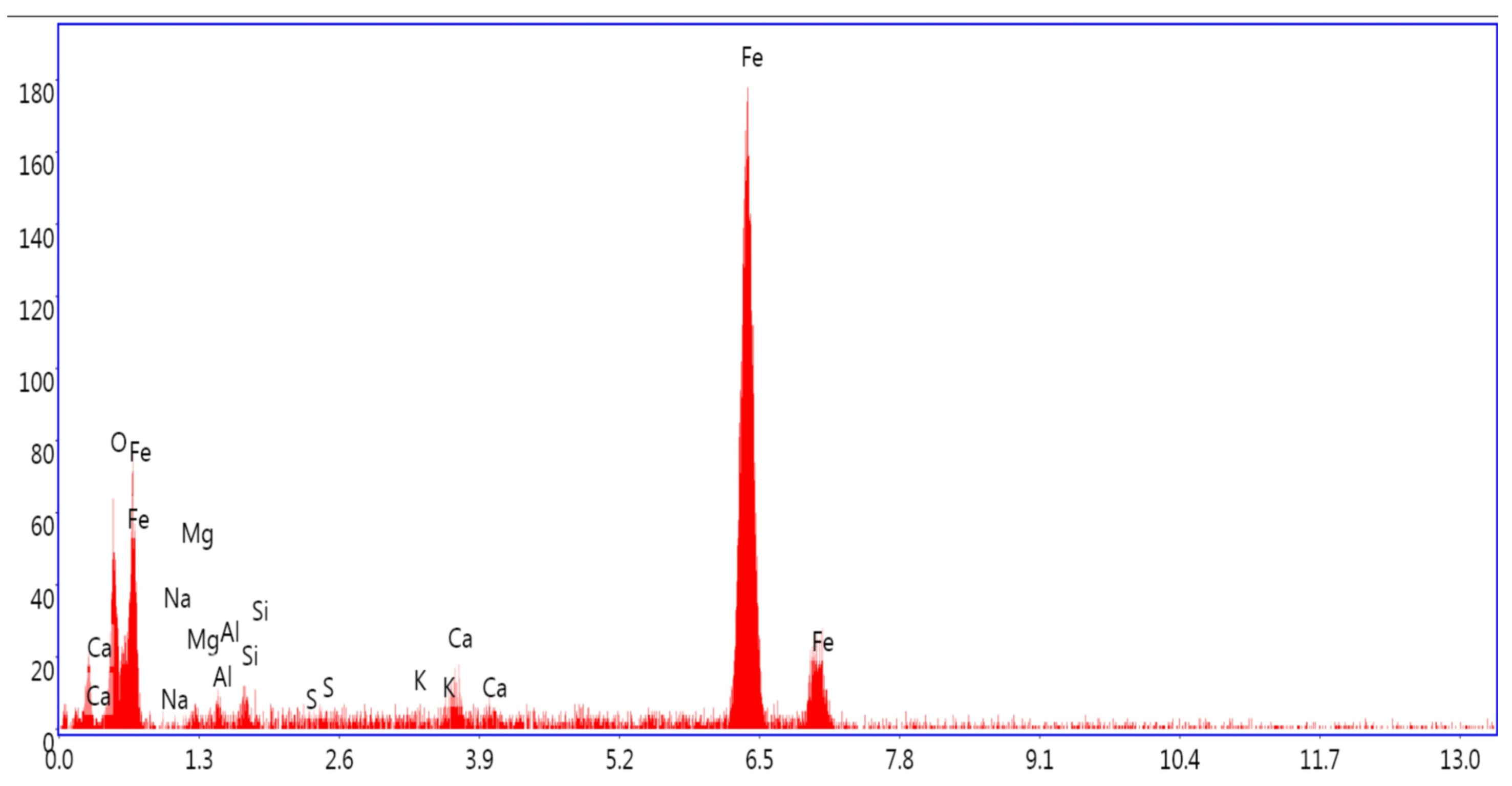
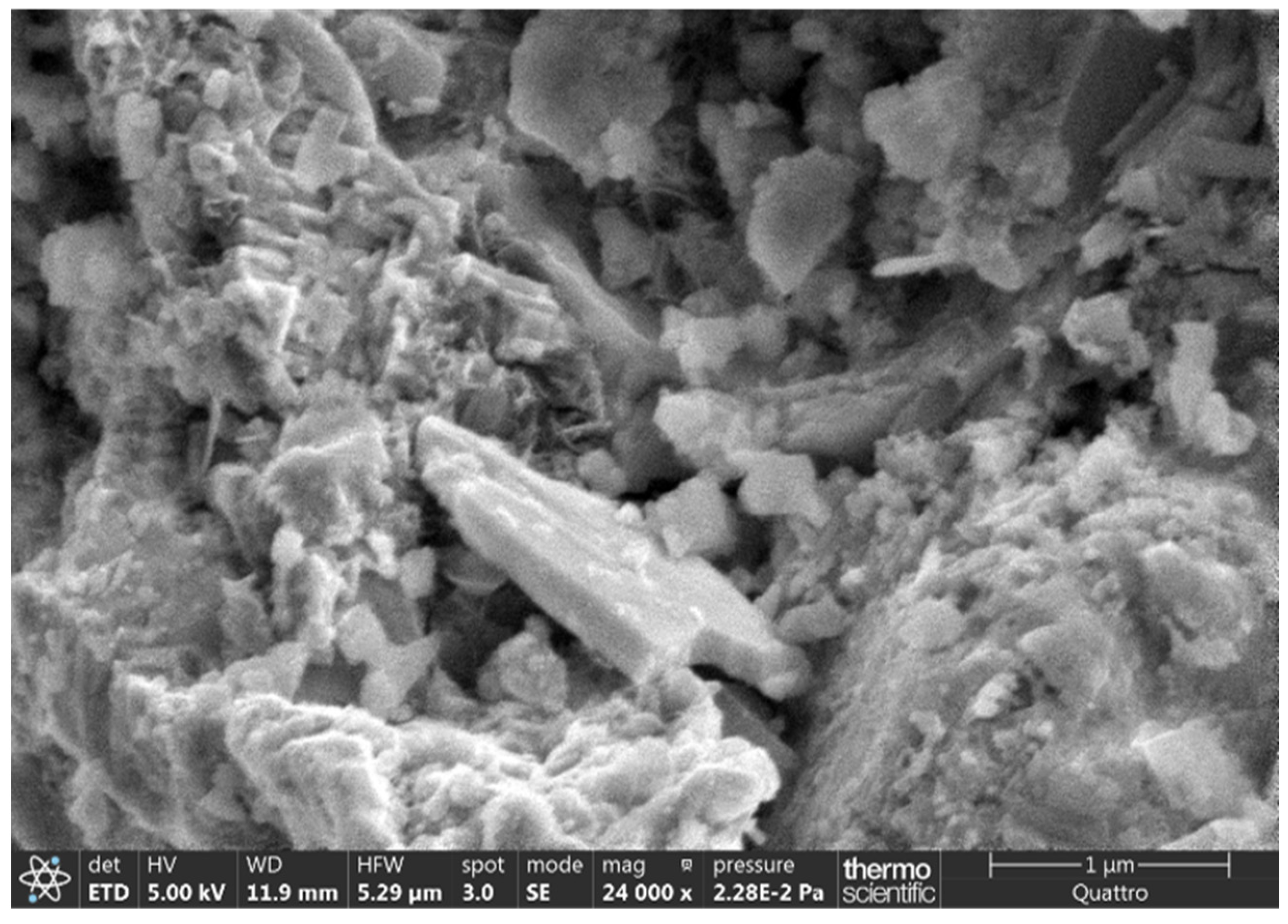


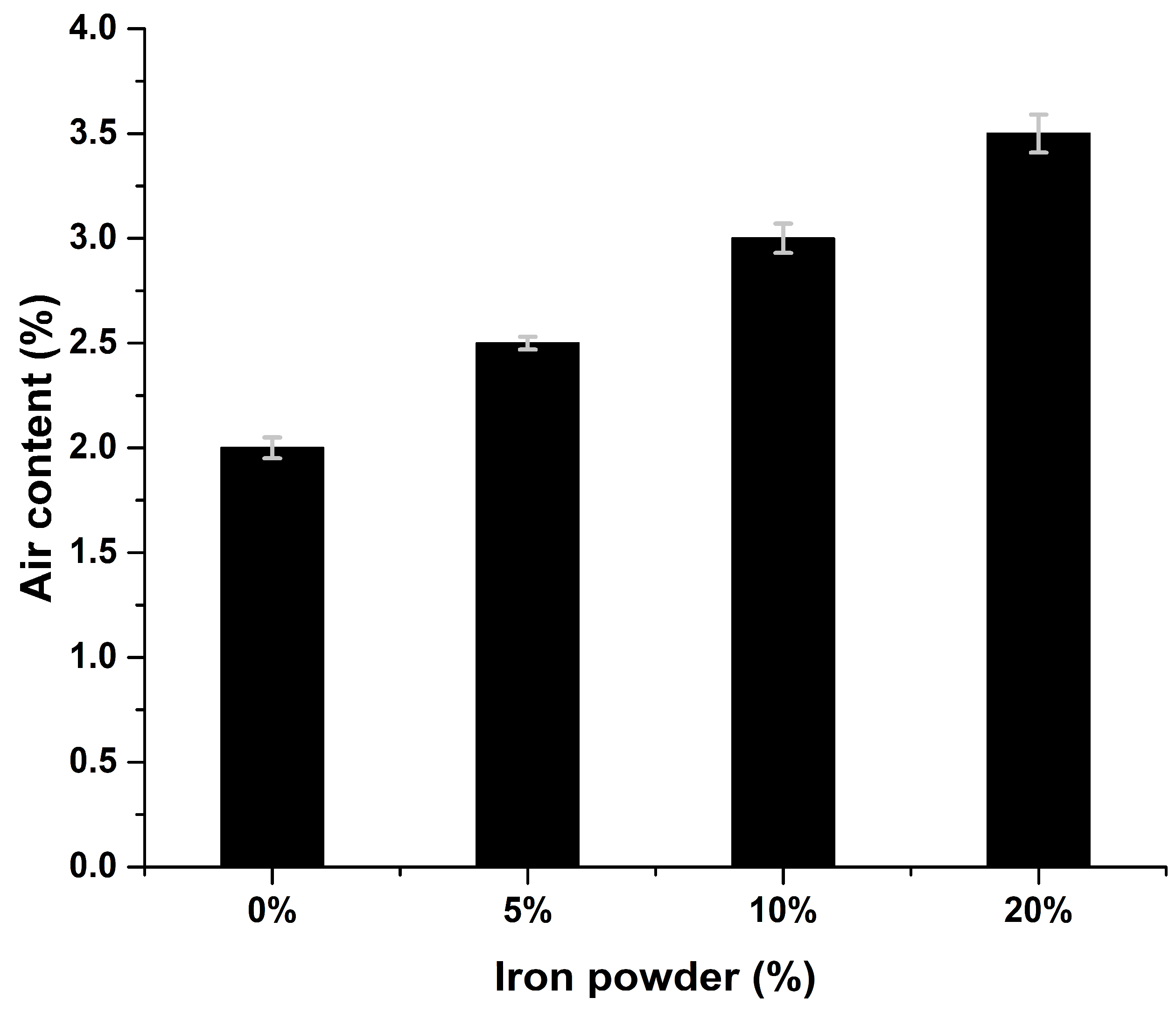
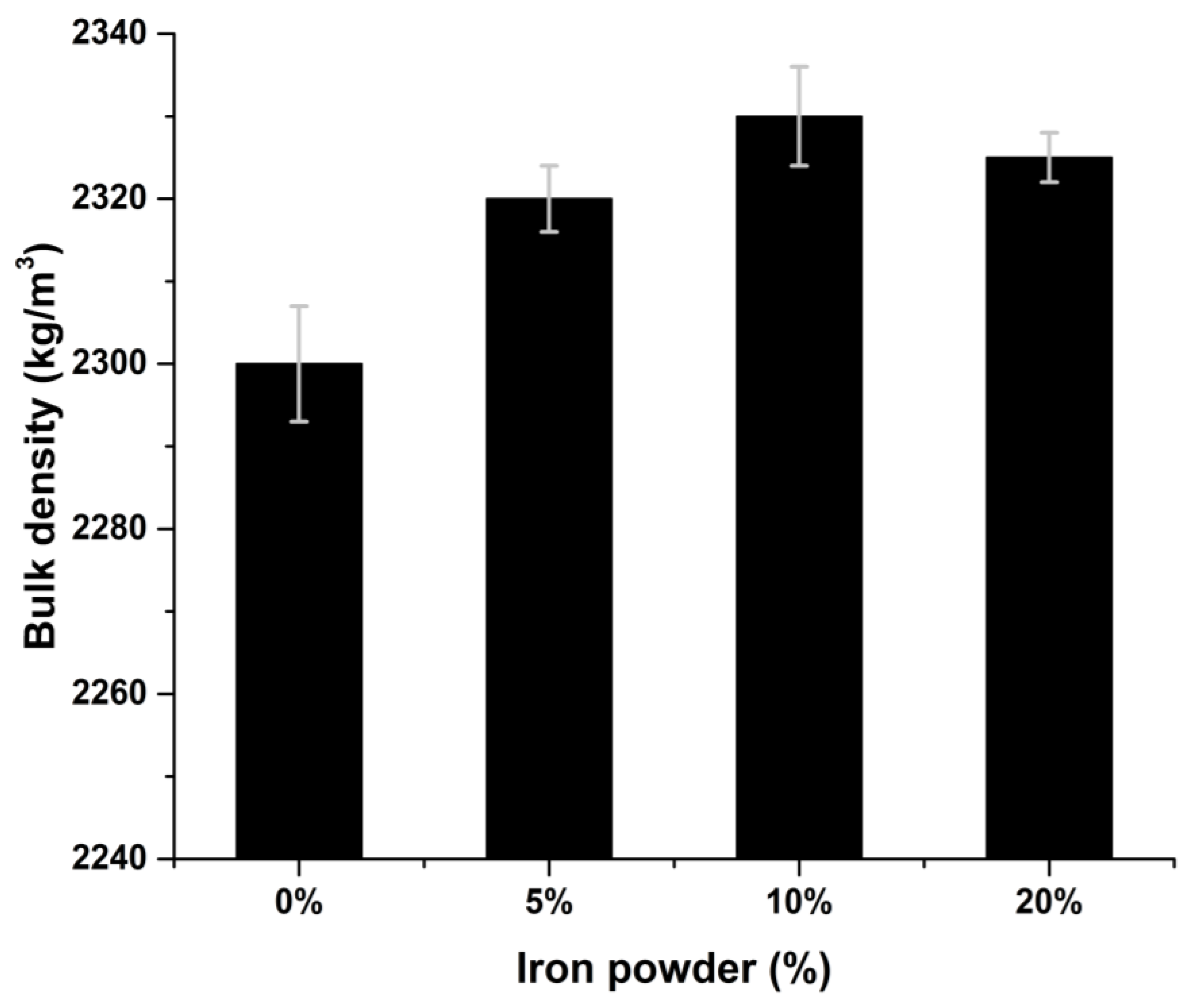



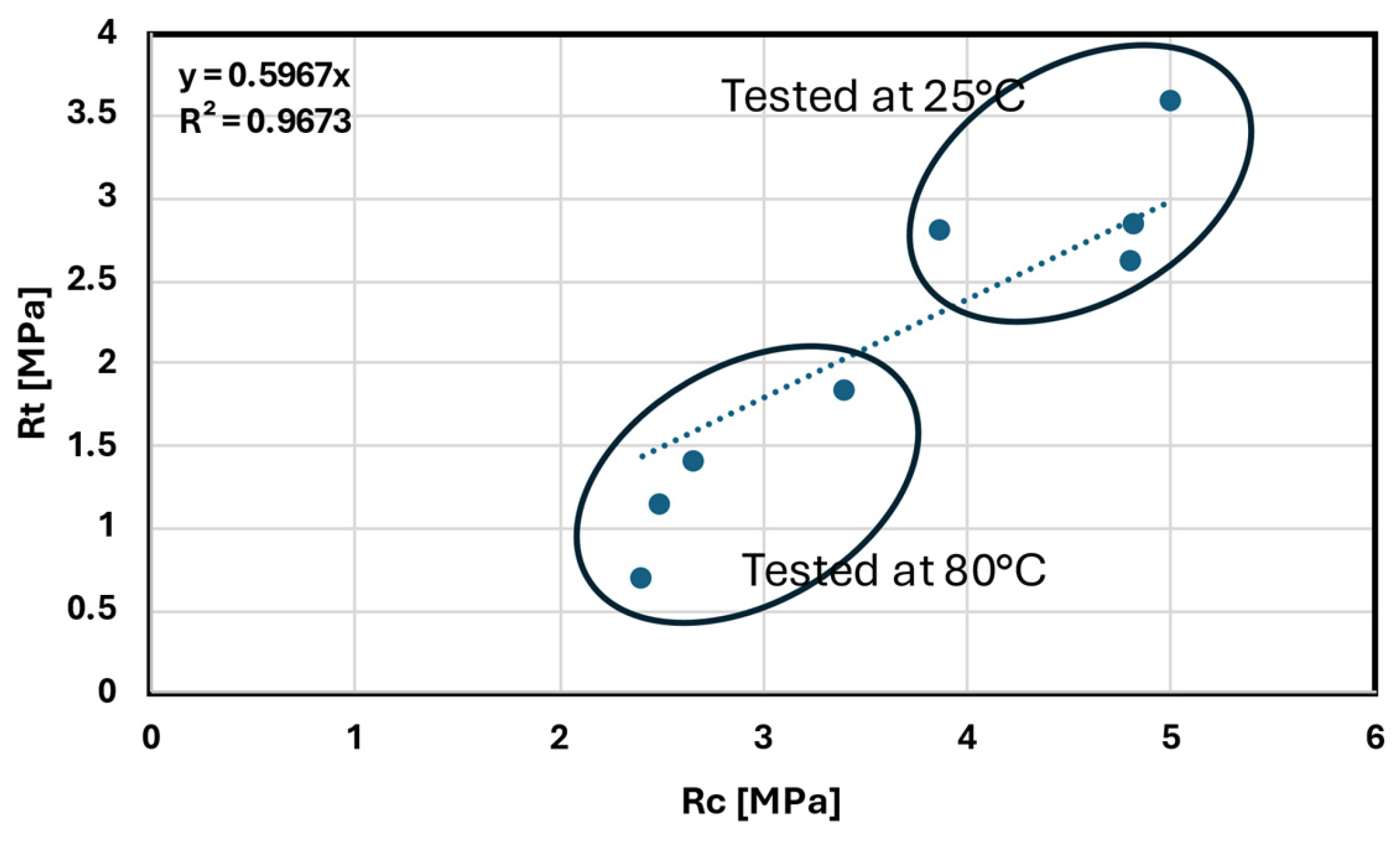
| SiO2 | Al2O3 | Fe2O3 | CaO | MgO | SO3 | K2O | Na2O | FeO | P2O5 | Cl | LOI | |
|---|---|---|---|---|---|---|---|---|---|---|---|---|
| Tuff (TUF) | 66.17 | 16.30 | 3.60 | 2.58 | 1.2 | 0.05 | 4.25 | 3.12 | n.d. | n.d. | 0.05 | 3.91 |
| Iron powder (IP) | 4.8 | 1.13 | 64.75 | 0.85 | 0.07 | n.d. | n.d. | n.d. | 1 | 0.05 | n.d. | n.d. |
| Element | Weight % | Atomic % | Net Int. | Error % | K Ratio | Z | A | F |
|---|---|---|---|---|---|---|---|---|
| O | 8.16 | 22.86 | 31.50 | 12.96 | 0.0435 | 1.2338 | 0.4324 | 1.000 |
| Na | 0.62 | 1.21 | 0.85 | 99.99 | 0.0011 | 1.1271 | 0.1530 | 1.0011 |
| Mg | 0.77 | 1.41 | 2.09 | 82.31 | 0.0021 | 1.1483 | 0.2432 | 1.0021 |
| Al | 0.73 | 1.21 | 2.81 | 75.39 | 0.0029 | 1.1075 | 0.3538 | 1.0040 |
| Si | 0.66 | 1.05 | 3.53 | 70.88 | 0.0036 | 1.1334 | 0.4771 | 1.0069 |
| S | 0.09 | 0.13 | 1.0197 | 83.66 | 0.0007 | 1.1128 | 0.7021 | 1.0197 |
| K | 0.21 | 0.25 | 1.24 | 77.35 | 0.0022 | 1.0572 | 0.8963 | 1.0764 |
| Ca | 1.97 | 2.20 | 10.33 | 32.66 | 0.0218 | 1.0777 | 0.9298 | 1.1077 |
| Fe | 86.79 | 69.68 | 231.40 | 3.55 | 0.8408 | 0.9683 | 0.9994 | 1.0011 |
| Physical Properties | |
|---|---|
| Specific density | 2750 kg/m3 |
| Apparent density | 1460 kg/m3 |
| Sand equivalent | 69% |
| Fineness modulus | 2.62 |
| Sample ID | SH Solution (g) | SS Solution (g) | Total Alkali Activator Solution (g) | Volcanic Tuff: VTF (g) | Iron Powder: IP (g) | S/P | CS (g) | Water (g) |
|---|---|---|---|---|---|---|---|---|
| GPM0 | 30.8 | 100 | 130.8 | 373.7 | 0 | 0.35 | 1121.1 | 186.85 |
| GPM5 | 30.8 | 100 | 130.8 | 355.01 | 18.68 | 0.35 | 1121.1 | 186.85 |
| GPM10 | 30.8 | 100 | 130.8 | 336.33 | 37.37 | 0.35 | 1121.1 | 186.85 |
| GPM20 | 30.8 | 100 | 130.8 | 298.96 | 74.74 | 0.35 | 1121.1 | 186.85 |
Disclaimer/Publisher’s Note: The statements, opinions and data contained in all publications are solely those of the individual author(s) and contributor(s) and not of MDPI and/or the editor(s). MDPI and/or the editor(s) disclaim responsibility for any injury to people or property resulting from any ideas, methods, instructions or products referred to in the content. |
© 2025 by the authors. Licensee MDPI, Basel, Switzerland. This article is an open access article distributed under the terms and conditions of the Creative Commons Attribution (CC BY) license (https://creativecommons.org/licenses/by/4.0/).
Share and Cite
Khouadjia, M.L.K.; Bensalem, S.; Belebchouche, C.; Boumaza, A.; Hamlaoui, S.; Czarnecki, S. Sustainable Geopolymer Tuff Composites Utilizing Iron Powder Waste: Rheological and Mechanical Performance Evaluation. Sustainability 2025, 17, 1240. https://doi.org/10.3390/su17031240
Khouadjia MLK, Bensalem S, Belebchouche C, Boumaza A, Hamlaoui S, Czarnecki S. Sustainable Geopolymer Tuff Composites Utilizing Iron Powder Waste: Rheological and Mechanical Performance Evaluation. Sustainability. 2025; 17(3):1240. https://doi.org/10.3390/su17031240
Chicago/Turabian StyleKhouadjia, Mohamed Lyes Kamel, Sara Bensalem, Cherif Belebchouche, Abderrachid Boumaza, Salim Hamlaoui, and Slawomir Czarnecki. 2025. "Sustainable Geopolymer Tuff Composites Utilizing Iron Powder Waste: Rheological and Mechanical Performance Evaluation" Sustainability 17, no. 3: 1240. https://doi.org/10.3390/su17031240
APA StyleKhouadjia, M. L. K., Bensalem, S., Belebchouche, C., Boumaza, A., Hamlaoui, S., & Czarnecki, S. (2025). Sustainable Geopolymer Tuff Composites Utilizing Iron Powder Waste: Rheological and Mechanical Performance Evaluation. Sustainability, 17(3), 1240. https://doi.org/10.3390/su17031240






